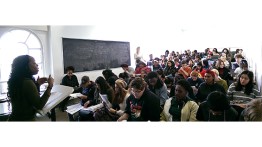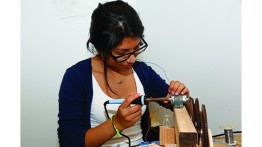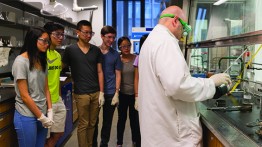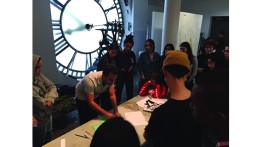Outreach Programs: A Parallel Union
POSTED ON: March 24, 2017
When Samer Houzayn, an engineer from Sixth of October City near Cairo arrived in New York, he started Googling terms such as “immigrant,” “education” and “helping immigrants.” He hit on The Cooper Union’s Retraining Program for Immigrant Engineers, but had his doubts when he learned that all classes were free.
“I said, ‘I don’t believe it could be true!’ But a friend of mine who had gone through the program said, ‘Yes, it’s real!’” After only four months in the United States, he found himself in a certificate program that allowed him to convert his skills as a petroleum engineer into becoming an MEP engineer—one who designs and maintains mechanical, electrical and plumbing systems—a skill set that is in far greater demand in New York.
According to Siri Comeau McDonald, Cooper’s new director of corporate and foundation relations, Houzayn is one of thousands of people who have benefitted from the many “outreach” educational efforts run at The Cooper Union that provide free or low-cost classes for working people and youth beyond its matriculated students. “Each year these outreach programs provide classes to a population nearly as large as Cooper’s full-time student body. This aspect of Cooper’s service to the people of New York City may be less well known, but its impact on the lives of those with great need is no less meaningful,” she says. Comeau McDonald gathered data on these programs and discovered impressive results. As a kind of parallel union, outreach classes at Cooper offer a broad scope of subjects to students of varied ages and origins, and this past year, served more than 1,000 people. The programs demonstrate that, in an era of dwindling opportunities for the poorest and most vulnerable New Yorkers, Cooper is still helping people acquire skills for meaningful work.
“The Cooper Union is an oasis,” says Marina Gutierrez, director of the Saturday Program, the oldest of Cooper’s outreach efforts. “It’s the direct descendant of Peter Cooper’s imagining a world where it’s possible for all citizens to become literate and articulate in culture and politics.” The Saturday Program was founded by students of the School of Art in 1968 during a larger, national movement to make access to higher education more equitable by organizing alternative schools where college undergraduates would teach students coming from poorly performing school districts. This was exactly the spirit in which many of the outreach programs at Cooper began: a commitment to putting quality education within reach of all.
COLLEGE PREPARATION
In 2015 alone, approximately 65 percent of high school seniors in New York City’s public schools were deemed unprepared for college-level work, according to the city’s Department of Education. This stems in part from schools that are overcrowded, with poor facilities and outdated technology. To make matters worse, the arts have been the focus of continual budgetary cuts because they’re deemed elective subjects. But as copious research studies have shown, the arts are hardly ancillary; they are essential to effective learning for many students. That’s why Cooper’s tuition-free art programs for New York City high school students—the Saturday Program and the Outreach Pre-College Program—have proved particularly meaningful to students who had never before imagined that their interest in art could be anything but a hobby. “I had a very abstract idea of what an artist was,” says Jairo Sosa, a senior in the School of Art who is both an alumnus of the Saturday Program and now one of its sculpture instructors. Although he attended a highly rigorous public charter school, Sosa, a Bronx native, found that he had to actively seek art instruction outside his high school if he wanted to go to a competitive art school. He learned about the Saturday Program from a guidance counselor’s bulletin board, applied and suddenly found himself part of a community of highly talented artists, undergraduates at Cooper whose virtuosity inspired him to push the limits of his own work. “To me, those teachers were superstars.”
The art programs include classes in drawing, painting, sculpture, animation, 2-D design, 3-D design, photography, graphic design, portfolio preparation and printmaking— the only free printmaking course available to New York high school students.
Cooper’s multiple STEM (science, technology, engineering and mathematics) outreach programs are similarly designed to meet the needs of underprepared students while introducing them to science-related fields. In 2016 alone, the STEM programs served 362 students. Most run at no cost to them. The programs include Summer STEM, a six-week program for high school sophomores and juniors in which students work in teams to solve an engineering problem while learning presentation and writing skills; STEM Saturdays, a 10-week, tuition-free program held twice during the school year that teaches high school students basic engineering concepts; STEM Days, one-day science workshops provided free of charge for fourth through twelfth graders; and High School Inventors, in which students from two neighborhood high schools are immersed in a rigorous, hands-on engineering project. After designing and building a Rube Goldberg machine, they compete against high schools from all over the region. Cooper Union students, who act as mentors for the younger students, teach many of these courses.
George Delagrammatikas, associate professor of mechanical engineering and the director of all of Cooper’s STEM outreach programs, designs them with an eye to bringing in students who are not traditionally represented in STEM careers. Last year’s Summer STEM session consisted of 86 girls, 42 percent of the 212 attendees. Almost half the group was made up of Asian students; 11 percent were Latino, and 10 percent were African American. “If the instructor or teaching assistant is a person of color or a woman, that’s when the students get inspired and gain confidence that they can also achieve those positions,” Delagrammatikas, says.
WORK PREPARATION
The Retraining Program for Immigrant Engineers has even greater diversity, with women making up a third of its approximately 225 students per year. In spring 2016, participants came from all points across the globe, including 30 percent from the Middle East and North Africa and 26 percent from Europe and Central Asia. Some are refugees; others are victims of human trafficking. The program is co-run with CAMBA, a nonprofit organization in Brooklyn, that provides in-depth workshops for resume writing, preparing for interviews and job readiness. They also pair students with industry-specialized job developers. Since the program teamed with CAMBA, job placement rates in engineering fields have risen. In fact, in spring 2016, 89 percent of the placements were in engineering-related jobs. In its 26-year history, the program—which has no equivalent in the New York area—has served more than 4,700 people.
Rustem Urmanshin, a software developer from Moscow who arrived in New York a year ago, attends the program to study software quality assurance, Structured Query Language, Linux and Java. “It’s a great program for immigrants, especially for engineering education because I have graduated in Russia from a technical university. All of the courses are in English. I’m an immigrant so I must study. I do my best,” he says. Houzayn adds that the practicality of the courses makes them highly useful: “I take these courses in order to know what’s going on in New York City,” he says. “Also, these teachers are already in the field, so they transfer what’s going on in the street.”
Besides the students who take outreach classes, Cooper undergraduates who work as student instructors benefit mightily from the constellation of programs Cooper offers. As a Saturday Program instructor, for instance, Sosa received extensive teacher training. He is determined to teach his high school students both artistic skills and art-historical context. “I try to give them the best of whatever I’ve gotten from my Cooper professors. When they enter the program, they don’t have a lot of cultural capital, so we try to ameliorate that.” Sosa, who is Dominican, adds, “I look like some of our students and that makes a huge difference. Many people of color have been written out of art history, and students need to know that there were and are artists from all backgrounds.”
KEEPING IT TUITION FREE: FUNDING OF OUTREACH PROGRAMS
Materials, instructor fees, overhead costs—all these add up to substantial expenses for these programs, most of which don’t generate tuition. Even informing students about the programs is a big job—and an expensive one. Stephanie Hightower, a co-director of the Outreach Pre-College Art Program, notes that besides a faculty advisor, her program works with a professional recruitment representative to visit area public schools and add new content to the program’s online information. “We have three annual art exhibitions with poetry readings open to the public on campus; we have a comprehensive, up-to-date database of contact information for more than 800 people who work with high school students, including counselors, teachers, principals and directors of cultural institutions. We mail and email exhibition invitations and send printed catalogs to our most key people.”
All these costs are underwritten by an assortment of funders, who are consistently impressed with the innovative ways that the Cooper outreach programs fulfill many of the most important educational goals for underserved and underfunded New York City communities: academic preparation; social development exercises that teach students to collaborate; and a fusion of content with activities. Funders such as the Jacques and Natasha Gelman Foundation, the Altman Foundation and the Jeffrey and Paula Gural Foundation (among a host of benefactors) have consistently given to the Saturday Program and Art Outreach. To encourage individual donors to pitch in too, Richard Lincer, former chair of the Board of Trustees, matches any individual gift to the Saturday Program up to $15,000 each year.
The Robin Hood Foundation, a group dedicated to funding poverty-fighting initiatives, has given generously to maintain the Retraining Program for Immigrant Engineers. A leadership grant from the Alfred P. Sloan Foundation and support from the Pinkerton Foundation let Cooper launch STEM Saturdays last year to reach more students during the academic year. Besides the funds needed for salaries and daily materials, these grants pay for the microcontroller kits and laptop computers that students use during the 10-week program. Those who successfully complete all the assignments and have perfect attendance are awarded the kits and laptops to keep at the conclusion of the program. Summer STEM’s most generous donors include Con Edison, the Henry Sterne Trust and the Pinkerton Foundation. Their donations allowed more than half of last year’s students to attend free of charge or at a discounted rate. The High School Inventors program is financed by grants from the participating high schools, LaSalle Academy and Grace Church School.
LONG-TERM IMPACT FOR STUDENTS AND CITY
No matter what they choose to study in the future, outreach students are highly likely to attend college. For instance, 94 of the 114 seniors in the 2015–16 session of the Saturday Program attended college the following fall. All of the 46 students in the Outreach Pre-College Program were accepted to college in the same year. And students already in college—namely Cooper’s undergraduates who act as mentors and instructors in the outreach programs—have reported that their work with high school students has both strengthened their own academics and broadened their sense of career possibilities. Yeeho Song, a senior in mechanical engineering who was one of 40 student instructors teaching in the 2016 Summer STEM program, says of his experience, “I get a chance to practice how to convey complex ideas in a simple method that people can easily understand, which I think is important in the field of engineering.” His colleague Max Summers, who is a senior in civil engineering, finds teaching “the most engaging and perhaps fulfilling job I have ever had. The experience has me asking myself many new questions about what I would like to be doing once I graduate from Cooper. The program has shown me that there is more to engineering than getting a job at a firm, or going to grad school to specialize in a subset of engineering.”
At the same time, these programs are helping ensure that the New York workforce will be increasingly diverse. Maureen Anyanwu, a senior chemical engineering student who worked as an instructor in the Summer STEM program, points out that the more women and people of color in science and tech fields, the greater innovation we can expect. Summers concurs: “Greater diversity in the field would result in breaking stigmas and opening opportunity to more and more individuals who are underrepresented and therefore unheard. This would have an immediate impact on the quality and diversity of new engineering ideas, solutions and even problems we didn’t know we had to solve.”
In describing the most recent class of High School Inventors—the students tasked with designing and building a Rube Goldberg machine, who participate in a regional competition—Delagrammatikas notes that a team from a low-income high school with students from all four grades won second place. They were competing against teams made up of seniors from some of the city’s best high schools. “These events show students from all socioeconomic and ethnic backgrounds that they are truly capable of achieving with the right mentorship and resources,” he says. “They become more confident as they achieve and struggle through the program, and gain a better understanding of what it means to be on a team and to think creatively. And they recognize very quickly that they can do anything that students from other schools can do.”
The impact is even more immediate for students in the Retraining Program for Immigrant Engineers. While the average starting wage of participants in the past two years was $9 an hour, after attending the program their starting wage was, on average, $21 an hour. For instance, Craig Fagan, who moved to New York from Jamaica, took courses in National Electrical Code and Linux in 2016 and now earns $44 an hour as a roaming engineer for T-Mobile. “The program brings immigrant professionals together, helps them expand their professional network and provides opportunities to take advantage of those connections,” he says.
Besides having a direct impact on New York’s economy, the program’s alumni are working at jobs that keep the city running. In fact, one graduate, Ben Abanilla, is now employed as a senior electrical inspector for Parsons Brinckerhoff, where he works on the Second Avenue Subway, a project that abounds with Cooper alumni (see story on page 24).
“For nearly 50 years, The Cooper Union’s outreach programs have shared the incredible wealth of talent and creativity found at Cooper with New York City’s at-risk populations,” says Delagrammatikas. “Cooper’s program directors, faculty and students are removing barriers to education and employment. I like to think that Peter Cooper would be proud.”








